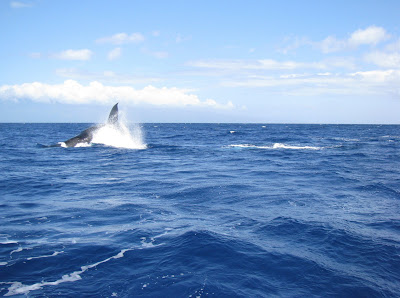 This fellow was chirping at us and he happened to sit still long enough to let me get his picture. The next few pictures are of our whale watch. The catamaran pulled up to the beach and put down a ladder. We took off our shoes and headed into the sand and then the water. The first two steps were in the water. There were approx. 25-30 people on board. The water was really rough, and that made it hard to get good pictures because it was hard to stand up, balance, and take a picture of a fast moving creature in the water at the same time. We got to see (as far as the captain could tell) about four males chasing/competing for one female. He told us that to see something like that is about a 1 in 1,000 chance. We didn't see them for a few minutes and he said that the female was probably hiding under the boat and the males won't go after her then. He moved the boat, and the chase began again. They were humpback whales. They spend the winters in the Hawaiian waters, about 7,000 to 10,000 of them, and most of them are found in the waters around Maui, then they head back to Alaska. They measure 45 to 52 feet long and can weigh up to 80,000 pounds. You can stand on shore and see them jump out of the water, but it was nice to see them a little closer. And with the rough water being what it was, we did get wet! Thank goodness I was turned away from it all cause I had the camera in my hands.
This fellow was chirping at us and he happened to sit still long enough to let me get his picture. The next few pictures are of our whale watch. The catamaran pulled up to the beach and put down a ladder. We took off our shoes and headed into the sand and then the water. The first two steps were in the water. There were approx. 25-30 people on board. The water was really rough, and that made it hard to get good pictures because it was hard to stand up, balance, and take a picture of a fast moving creature in the water at the same time. We got to see (as far as the captain could tell) about four males chasing/competing for one female. He told us that to see something like that is about a 1 in 1,000 chance. We didn't see them for a few minutes and he said that the female was probably hiding under the boat and the males won't go after her then. He moved the boat, and the chase began again. They were humpback whales. They spend the winters in the Hawaiian waters, about 7,000 to 10,000 of them, and most of them are found in the waters around Maui, then they head back to Alaska. They measure 45 to 52 feet long and can weigh up to 80,000 pounds. You can stand on shore and see them jump out of the water, but it was nice to see them a little closer. And with the rough water being what it was, we did get wet! Thank goodness I was turned away from it all cause I had the camera in my hands.





Skeleton of a sperm whale. We visited the Whale Musuem, which was free, and learned a lot about the whaling industry in Hawaii. It was actually the whaling capital of the Pacific between 1825 to 1860. Residents boasted in 1856, "You can walk from one end of Honolulu Harbor to the other, ship to ship, without getting your feet wet!". 596 ships came into port that year.

Tools used to cut apart the whales.

Blubber from a pilot whale, cut into "bible leaves" to get ready for the try pot.

Scrimshaw - the art of etching on ivory whales' teeth.

Replica of a whaling ship.

Krystle

Rhonda

Yours truly

Sisters

Hawaiian plant called protea.





 Skeleton of a sperm whale. We visited the Whale Musuem, which was free, and learned a lot about the whaling industry in Hawaii. It was actually the whaling capital of the Pacific between 1825 to 1860. Residents boasted in 1856, "You can walk from one end of Honolulu Harbor to the other, ship to ship, without getting your feet wet!". 596 ships came into port that year.
Skeleton of a sperm whale. We visited the Whale Musuem, which was free, and learned a lot about the whaling industry in Hawaii. It was actually the whaling capital of the Pacific between 1825 to 1860. Residents boasted in 1856, "You can walk from one end of Honolulu Harbor to the other, ship to ship, without getting your feet wet!". 596 ships came into port that year.









0 comments:
Post a Comment